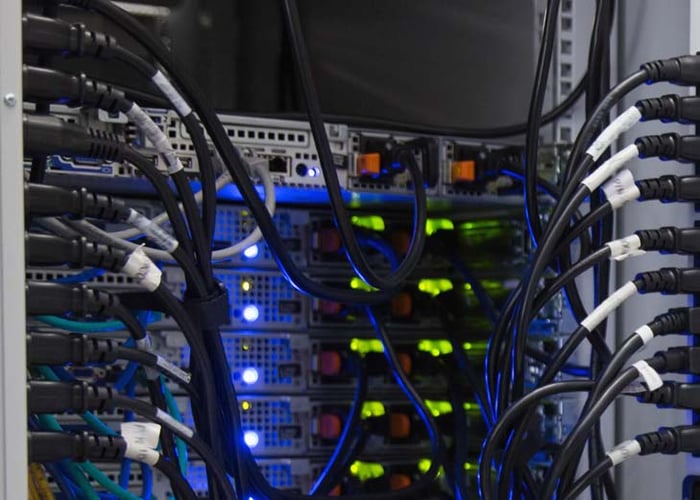
Whether your network cabling is structured or unstructured, the need to add or replace existing integrated hardware connected to those cables is inevitable. This includes equipment and devices such as servers, routers, switches, uninterrupted power supplies, external backups, monitors, and printers. It may also include industry-specific testing and research equipment that has native ethernet ports and is powered by alternating current.

One convenient setup may include a NEMA 5-15 (5-20, 6-15, and 6-20) power cord which plugs into the mains power while the opposite end, terminated with an IEC connector, plugs into a server, or the inlet on a power distribution unit (PDU) or an accessory power strip (APS). IEC Jumper cords with a plug on one end and a connector on the other, can now be plugged into the PDU or APS to keep AC-powered equipment integrated in one unit—or adjacent units or racks—which helps simplify architecture.
Below is the continuation of last month’s snapshot of data centers:
Colocation Data Centers
Colocation centers or “colos” are typically large facilities that rent storage space such as rack units or individual racks for servers, routers, and other network devices. These types of centers typically work well for businesses that don’t have the physical space or the capital to provide proper cooling (air, water), or the physical security needed both inside and outside the facility.
Colocation centers also provide the connections for networking equipment. These types of centers are a good fit for companies doing business nationwide—they can network in several colocations, thus reducing latency to their end users. While colocation centers offer rack space and network connections, they also provide other services.
Colocation centers may offer managed services, including the hybrid cloud. When cloud companies rent colocation space, it shows the overlap different data centers may have with one another. Other colocation benefits include rack cooling (overhead costs) and good perimeter and internal security. Of course, all of this comes with an up-front fee, which is typically a pay-as-you-go model.
Cloud Data Centers
A cloud data center (public) is a type of center in which the cloud company manages and takes care of the actual hardware with the help of a third-party managed services provider. Clouds are a trending option as they allow clients the freedom to run applications, manage websites and data within virtual infrastructures while storing data on multiple servers at multiple locations—redundancies to further ensure data retrieval.
When data is uploaded to cloud servers, it is duplicated across various locations. The cloud provider guarantees to provide multiple backups. This is especially helpful for click-and-mortar businesses who need data backups for their regional or national chain of stores in case of a catastrophic event and consequent data loss.
Clouds can be public, private, or hybrids. The hybrid cloud allows companies to process data on their private cloud in combination with a third-party cloud provider (public). Clouds can be classified into four broad categories: Serverless, Platform as a Service (PaaS), Infrastructure as a Service (IaaS), and Software as a Service (SaaS).
Also, a company can contract with multiple public clouds putting them in the multicloud category. Public cloud services are often pay as you go, such as subscription-based and consumption-based models, in contrast to the traditional IT model that requires up-front expenditures for hardware and software. Clouds are popular choices for companies concerned with overhead costs, such as the public utilities needed to keep their centers running—water chillers, (electricity/water), air-conditioning with additional fans and blowers (electricity).
Enterprise Data Centers
Architecturally, enterprise data centers are designed to support private organizations with a large number of simultaneous end users. Enterprise centers can reside on-site or off-site, depending on where the majority of its end users are located. For example, if the organization is headquartered in Alaska, but the majority of its end users work or reside in the continental U.S., the enterprise center may likely reside in the continental U.S. to reduce latency within that larger subset of simultaneous end users.
The architecture of this data center is consistent enterprise-wide. As with most other centers, enterprise storage arrays include servers with either hard disk drives or solid-state disks—or a hybrid consisting of both—that move data between networks. To take advantage of its scale, multiple enterprise systems, though being separate autonomous centers, deliver consistent data modeling enterprise-wide. These centers may also be structured into separate ethernet and intranet centers.
The end result: the data processed by enterprise centers will be consistently modeled with corporatewide strategies resulting in consistent data processing, training, and overall applications.
| Click here to learn more about Interpower accessory power systems, including its Power Distribution Unit (PDU) Accessory Power Strips (APS), and jumper cables. |